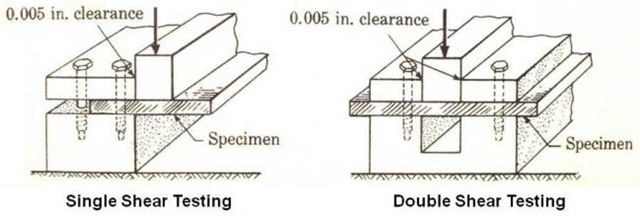Like tensile strength, shear strength and compression strength are also properties of a material. They are determined by shear test and compression test. Information about shear, shear test and compression test is given in this article.
Shear
As shown in figure given below, when a material is subjected to forces which cause it to twist, or one face to slide relative to an opposite face, it is said to be in shear. Compared to tensile and compressive stress and strain, the shear forces act over an area which is in line with the forces.

The force per unit area is called the shear stress, denoted by the symbol Τ (Greek letter tau). Thus,
Τ = (F) / (A)
Its unit is the pascal (Pa), where force is measured in newtons (N) and area in square metres. When shear stress is applied, there will be an angular change in dimension, just as there is a change in length when materials are under tension or compression. Shear strain, denoted by the symbol γ (Greek letter gamma), is defined as,
γ = (x) / (L) = tanΦ ≈ Φ
The angular deformation, Φ symbol (Greek letter phi) is expressed in radians. The last approximate equality results from the fact that the tangent of a small angle is almost the same as the angle expressed in radians. This is the reason why some texts give the radian as the unit of strain. Both shear strain and angular deformation are ratios, so have no units. However, it is not unusual for shear strain to be quoted in %, as with tensile strain.
Shear stresses are most evident where lap joints are fastened together and forces applied to pull them apart, but are also seen when rods are twisted
The shear strength of a material is the maximum stress that it can withstand in shear before failure occurs. For example, punching and guillotining apply shear stresses of more than the maximum shear stress for that material.
As with Hooke’s Law for tensile stress, most metals have a shear stress which is proportional to the shear strain. And in a similar way to Young’s modulus, the gradient of the graph is referred to as the shear modulus or modulus of rigidity.
Shear Test
Shear strength is the load required per unit area to produce a fracture when impressed vertically upon the cross section of a material. Methods of testing single and double shear are shown below.

Shear strength may be calculated as the amount of force needed to make the shear over a given cross sectional area.
Shear strength = (Applied load) / (Shear area)
In double shear, the force and the area are doubled, resulting in the same shear strength.
The shear strength of mild steels compared to ultimate tensile strength ranges from 60 to 80 percent. The lower values are for the harder materials.
Compression Test
Compression strength is the force required per unit area to produce a fracture when the cross section of a material is subjected to crushing load. Like tensile test, compression test is carried out on a universal testing machine. In this test, the specimen is subjected to end loading which produced a crushing action. Whereas in a tension test, the specimen elongates in a direction parallel to the applied load, in a compression test it shortens. By convention, the stress and strain are negative. For most engineering materials, Young’s Modulus is the same in compression as in tension. Compression test specimen is limited to such a length that bending due to column action does not take place. To avoid bending, a height-diameter ratio of 10 is suggested as a practical upper limit. For uniform stressing of the specimen, a circular section is preferred over other shapes. It is used for measuring strength of brittle materials and for calculating forces required in manufacturing processing which involve compressive deformation. Compression test ranks low on list of routine acceptance tests of metals.
